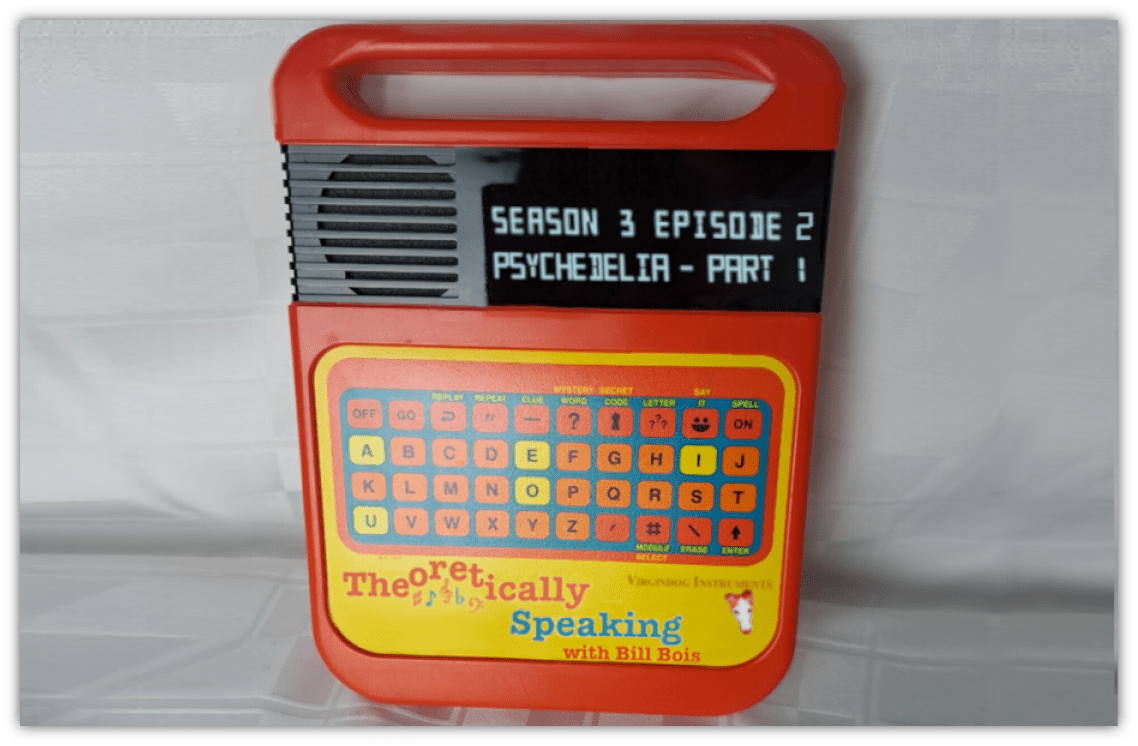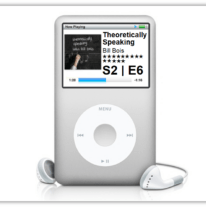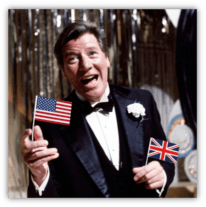Bill Bois’ Music Theory For Non-Musicians™
…if there was ever an art where breaking the rules is one of the rules, it’s music.
redditor u/COMPRIMENS
S3:E2- What Makes Psychedelia Psychedelia? Part 1
I didn’t think I’d have so much to say about psychedelic music. It might be the drugs talking.

Anyway, this genre is going to take two articles to cover adequately.
“Psychedelia” is any art, including music, painting, and fashion, conceived through the use of drugs or representing a mind expanding experience. That makes us think immediately of the 1960s, its heavy drug use, and its psychedelic music.
The word “psychedelic” wasn’t even coined until 1956.

That happened when English psychologist Humphry Osmond, in a letter to Aldous Huxley, combined the Greek words psukhḗ, meaning mind, and déelos, meaning to make manifest. Psychedelics, whether drugs or art, make your mind visible to itself.
Trippy, man.
However, psychedelic music, and the search for knowing your own mind, goes back farther than 1956.
Claude Debussy’s 1894 “Prélude à l’après-midi d’un faune” is impressionistic like the paintings of the time, though Debussy said there was no connection. It’s still regarded as a mind altering work, creating a mental image of a fawn’s afternoon and getting more abstract through its length, allowing the mind to explore its landscape.
And even before that, “Symphonie fantastique,” written by Hector Berlioz in 1830, is definitely psychedelic music. He was quite open about writing some of it under the effects of opium. Its subject matter is the story of a young man infatuated with a beautiful woman. He eventually realizes it’s unrequited and drowns his sorrows in opium. Under its spell, he imagines killing her, being executed for her murder, and suffering justice at the hands of witches and demons in the afterlife.
“Symphonie fantastique” caused quite a stir. It reflected Berlioz’s obsession with his wife who, he later found out, married him for his money. To write such a deeply personal piece was unseemly at the time. Perhaps the drugs made him do it.
Some argue that psychedelic music goes back at least as far as Hildegard von Bingen’s morality music plays of the 12th Century.
Also known as Saint Hildegard, she was a nun, mother superior, philosopher, writer, composer, and advisor to popes and politicians.

Her music used monophony, which is melody without underlying chords or harmony. If the melody is sung by multiple singers, they would sing the same thing but maybe an octave or a perfect fifth apart.
Her morality plays are psychedelic in that they intend to open the mind to the goodness of God and humanity despite the evil everywhere.
When the Devil appears as a character, his part is not sung, but spoken or shouted. There is no beauty in the Devil.
Hildegard wanted people to see God through her music. In the 1960s, people who wanted to see God took drugs. And we have no way of knowing how far back into prehistory people sought enlightenment through music, dancing, and certain mushrooms.
How do the drugs work?
Psychedelics suppress some neural networks in the brain and boost others. The main network in the average brain is called the default mode network, or DMN. Part of what it does is control thinking about oneself and others. Psychedelics suppress the DMN, and without that self-consciousness, the self is freed.
At the same time, other networks that don’t usually connect are able to work together. The aural and visual networks might connect so people can “see” music.
Drugs open The Doors Of Perception, as Aldous Huxley named his book. He got the phrase from a William Blake poem.
The Los Angeles band The Doors named themselves after Huxley’s work.

Psychedelic experiences can take hours, even an entire day. We call these long drug experiences “trips” because you pass through different psychic places. It’s also why so many psychedelic songs mention vehicles and magic, whether it’s a Magic Bus or a Magic Carpet Ride or any number of different space ships. It’s all a Magical Mystery Tour on the Journey To The Center Of The Mind.
As self-consciousness is suppressed, one can examine oneself without judgment and end the experience as a different, more aware person. The idea is to help you know yourself and seek improvement.
This is not necessarily an endorsement. Drugs are bad, m’kay?

The intelligentsia behind the psychedelic movements took it very seriously. Democracy had won World War II, but serious thinkers were dismayed that people used their freedom to conform.
A house, two cars, and two kids seemed the most anyone wanted.
There was no real individualism in the newly built suburbs.

The Beat Generation, including writers like Allen Ginsberg, William S. Borroughs, and Ken Kesey, formed a philosophy resisting capitalist society and its repressive nature.
As they explored drug trips to find meaning beyond conforming to societal norms, their objections became more spiritual. Organized religion doesn’t permit the individual exploration of the soul outside its own tenets.

Beatniks wanted individual freedom instead of an oppressive and conservative whole, and thought you could beat conformity by living spontaneously.
They were jazz fans and believed that life should be improvised like a jazz solo. If you freed the spiritual side of your mind, you could live without society’s rules and roles. You could be yourself.
Dr. Timothy Leary was a clinical psychologist at Harvard when he learned about and tried psilocybin while visiting Mexico. He wasn’t initially interested in spirituality like the beatniks but he came to believe that psychedelics could have positive effects in psychiatric treatments and promoted their use under controlled circumstances. Patients taking a trip must have a guide to help them maintain a connection to reality until the drug wears off.
Parenthetically, President Richard Nixon called Leary “the most dangerous man in America.”
Though if memory serves, Leary didn’t escalate the country’s involvement in an unwinnable war in Southeast Asia.

Unlike Ken Kesey’s Merry Pranksters, a commune of LSD users who lived up to their name, Leary was scholarly, meditative, and laid back. Kesey and the Pranksters believed society needed to be shaken awake, and pulled impromptu stunts to do so.

However, Leary and Kesey and the beatniks shared a belief that knowing yourself individually was the key to a better society. Love yourself, love others.
Make love, not war.
The psychedelic music of the 60s wasn’t influenced by Hildegard, Berlioz, and Debussy as much as it was by rock & roll, bebop, Indian classical, the Italian futurists, and the space age music I talked about in the recent article about easy listening. Esquivel’s music isn’t psychedelic, per se, but it sure doesn’t conform.
The futurists noted that the industrial revolution produced sounds never heard before. They suggested the clanging of machinery could be considered music. The composers behind musique concrète, which I also wrote about, used tape recorders to alter those sounds into music.
Composer Edgard Varèse incorporated tape players into the orchestra and, like the futurists, thought that noises are music. Anyone who isn’t used to certain sounds, he said, calls those sounds noise. An educated ear would call it music.

So when the electric guitar came along, feedback was at first considered noise. Feedback is what happens when an electric guitar’s pickups, which are microphones meant to “pick up” the sound of the vibrating strings, catch the guitar’s own sound coming out of the amplifier. The sound goes out of the amplifier into the guitar and out of the amplifier again and again, creating a high pitched squeal.
For examples, check out the intro of Steppenwolf’s Magic Carpet Ride or just about anything Jimi Hendrix ever did.
Though John Lennon claimed his feedback at the beginning of I Feel Fine is the first use of feedback on record, even he knew better.

“I defy anybody to find a record, unless it is some old blues record from 1922, that uses feedback that way,” he said in 1980. Those old blues records include great guitarists like Link Wray, Willie Johnson, and Johnny “Guitar” Watson. They knew what they were doing, and Lennon probably shouldn’t have dismissed their art, even if he did have more popular success.
The Beatles put feedback-as-music on record and also helped bring Indian music to Western ears, especially George Harrison. Indian music doesn’t use chord patterns like European and American music does. Instead, it’s a continuous flow of sounds and ideas. It can help induce trances which, like meditation, is a drugless trip.
1960s bands added traditional Indian instruments like sitars and tablas to their sound. Some bands, notably The Grateful Dead, would go off on long improvised jams, like bebop but also like Indian ragas.
The sitar became so popular that guitar manufacturers issued “sitar guitars.” They had extra drone strings, like a sitar, and produced a sound fairly similar to the real thing.
The musical exploration of the futurists, jazz artists, and space age experimentalists, combined with the beatniks’ search for the spiritual self, with or without drugs, is the start of what we now call psychedelic music.
A key moment in its formation is when The Beatles stopped touring in 1966. They then concentrated on recording and, as others have put it, used the studio as an instrument. They used tape manipulation, multi-tracking, and full orchestras. Some instruments, like the sitar and the Mellotron, aren’t good for touring but sound terrific in the studio. These kinds of choices and the otherworldly sounds they created are a big part of psychedelic music.
Let’s talk about lyrics for a second.
Is there really “a bridge by a fountain where rocking horse people eat marshmallow pies?” Probably not.

Is it a metaphor for something? Again, probably not. Do these lyrics mean anything at all? Yes, but only if you’re in the right frame of mind, and only you will understand them in that way. With the right outlook, or the right drugs, everything has meaning.
The heyday of psychedelic music was from 1966 to about 1970. There were three distinct types of psychedelic music through this period. There was psychedelic rock, folk, and soul. I’ll get into the details of each in Part 2 next week.
I’ll finish here with a quick look at the concert posters of the time.
They featured updated Art Nouveau motifs and freeform lettering that’s hard to read. Art Nouveau is an applied art, meaning it was used for practical purposes like advertising and signage, from 1890 to about 1910. It’s characterized by long curving lines, which is why peacocks and their long curved necks show up so often.
The posters of 60s psychedelia used lines like this, and peacocks, too. Sometimes Art Nouveau originals were copied and pasted, literally, and then updated into wild color schemes like you might see when your visual neural network is playing around with other networks. Letters and other shapes were rounded until they barely resembled themselves.
The posters promised a trippy experience where even the alphabet can’t be relied on.
Reality is an illusion. Live spontaneously.
Peace and love.



Suggested Listening:

Ordo Virtutum (Act III – Finale)
Hildegard von Bingen
1151

Symphonie fantastique (5th Movement)
Hector Berlioz
1830

Prélude à l’après-midi d’un faune
Claude Debussy
1894

Lure Of The Unknown Love
Yma Sumac
1950

I Hear A New World
Joe Meek
1960

Temptation
Esquivel
1966

I Had Too Much To Dream Last Night
The Electric Prunes
1967

Third Stone From The Sun
The Jimi Hendrix Experience
1967

Time Has Come Today
The Chambers Brothers
1967

White Rabbit
Jefferson Airplane
1967

Tales Of Brave Ulysses
Cream
1967

Journey To The Center Of The Mind
The Amboy Dukes
1968)

Magic Carpet Ride
Steppenwolf
1969
(Let the author know that your liked their article with a “Heart Upvote!”)





I love that you include Yma Sumac in your list. I doubt it was ever meant to be psychedelic, but her singing can really take you to a higher plane sometimes.
I for one do recommend people to try psychedelics, but responsibly. People like Leary were a bit Utopian in their faith in the power of LSD to improve society, but it does have real power as an individual’s tool for spiritual awareness and therapeutic growth (not to mention creativity).
No one should think of it as mere entertainment or escape. It’s the furthest thing from escape! It’s a journey through your own mind, one that often includes paths to dark thoughts and uncomfortable feelings. That’s all part of the vision quest. Those who don’t feel ready to commit to 8+ hours of such intensity should refrain, but I feel like everyone should try it at least once in their life, whenever they are ready to do so.
You’ve captured a huge range of influences here (appropriately, given the expanded perspective), and have touched on so many parts of my blog–which happens to be stuck at this juncture of student counterculture in the 60s. I need to get off my butt and actually write the thing!
Eastern influence was huge, not just Indian music but also Chinese and Japanese. Other than Debussy, Henry Cowell was essential for spreading Eastern sounds in his work, then Harry Partch, but most importantly John Cage, who spread Eastern philosophy as well as musical ideas. He was arguably the most crucial influence for the rise of Neo-Dadaism that became known as Fluxus.
This movement would include many artists around the world (including Yoko Ono, who was doing weird shit while Lennon was still living in Germany). It also included La Monte Young, whose 1958 piece Trio for Strings was an Eastern-inspired drone that clearly set the stage for psychedelic music:
https://www.youtube.com/watch?v=mlIyN6ZJgeA
Around the time when the Beatles released “I Feel Fine,” John Cale released this distorted guitar piece with Young:
https://www.youtube.com/watch?v=N_FkQdN4M4g
Which, to me, pushed guitar music far further than anything else at the time.
Apparently a big influence on the likes of Pink Floyd was the group AMM, but I can’t really get into their music (and that’s saying something)!
Everyone’s influenced by someone else, and there’s no one starting point to something as huge as psychedelia. Still, as far as recorded psychedelic rock goes, it’s hard to get earlier than Pink Floyd, who were recording freaky ditties when Lennon was just feeling fine:
https://www.youtube.com/watch?v=OL_82YyVBC4
(I know I’m giving John a hard time, but with that snotty “blues from 1922” comment, he was just asking for it!)
Another great entry, Bill. Can’t wait for Part 2!
Yma Sumac is really out there, so she fits this genre as well as anything Esquivel ever did. I’m unfamiliar with La Monte Young but I’m listening now and you’re right. He fits in, too.
As you say, responsible use is key when tripping. It’s not like having a beer while watching sports on TV. It’s much more involved and involving. Be educated and prepared in advance.
Likewise, you’re right to say it’s good when people are ready. I’d add that it’s also good to know when to stop. One trip or six, but there’s a point of diminishing returns and we don’t want anyone being the next Syd Barrett.
Looking forward to your blog!
Yes, important caveat. Probably don’t try psychoactive drugs if there is a personal or family history of schizophrenia, schizotypy, bipolar disorder, or other possible paths to psychosis.
Syd Barrett and Daniel Johnston both serve as warnings there!
Great stuff as ever. Love that you take it way back into history to round out all of the elements that coalesced to create the psychedelic movement both in terms of the music and in society. Lot of love for I Had Too Much To Dream Last Night from here, picked up the 7 inch at a record fair as a teenager and one of my favourites of the era.
Man, I am not a total classical music know-it-all, by a long shot. But I think I could listen to anything by Debussy. That stuff is awesome.
Looking forward to the mind-expanding experience of part 2.
I won’t be surprised if you include them next week, but I just wanted to shout out the 13th Floor Elevators, who are sometimes credited as the first Psychedelic rock band.
https://www.youtube.com/watch?v=E5ChfmIkgNE
You know me so well.
Psychedelic music is kinda like plastic surgery in my opinion. Do your due diligence, go in prepared, and you’ll have amazing results. Approach it half-assed and on the cheap, and not only is the result a mess but will probably permanently scar you. But it’s an option – you don’t HAVE to do it.
I can see how a creative mind would love to tap into the well deeper and see what the results might be – the excitement of what might result I’m sure is beyond intoxicating, to say the least.
Most fascinating read, Bill; intrigued to see what you unveil in part 2!
Nom-nom-nom…
People are making fun of Jennifer Lopez on the mothership. Whatever work she had done, I think the surgery went well. I’ve learned impulse control over these past four years. I know when to just stay out of it.
EXCELLENT article – great work!
I am also on Team “Try Psychedelics, but in a responsible, controlled manner” – they can truly change your life.